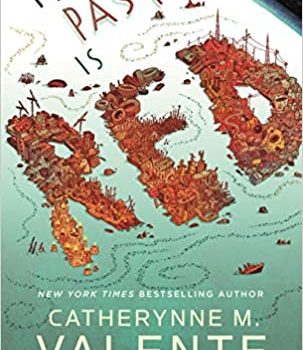Gary K. Wolfe Reviews The Past is Red by Catherynne M. Valente
 The Past is Red, Catherynne M. Valente (Tordotcom 978-1-250-30113-0, $20.99, 160pp, hc) July 2021. Cover by John Hendrix.
The Past is Red, Catherynne M. Valente (Tordotcom 978-1-250-30113-0, $20.99, 160pp, hc) July 2021. Cover by John Hendrix.
There were quite a few provocative tales in Jonathan Strahan’s 2016 anthology Drowned Worlds, but the most memorable narrator in the book was probably Tetley Abednego from Catherynne M. Valente’s “The Future is Blue”, the Sturgeon Award winner which became the title story of Valente’s 2018 collection from Subterranean. Now Valente gives us a good deal more Tetley in The Past is Red, which begins with that earlier novelette and then picks up Tetley’s story from a decade later, when she’s 29 years old. Tetley is as cheerful and Candide-like as ever, even though she lives in Garbagetown, a community built on the Great Pacific Garbage Patch, grown so dense that it can support whole neighborhoods named after their particular kinds of trash – candles, batteries, auto parts, drugs, etc. Otherwise, the planet is completely inundated, but with a handful of floating communities like Brighton Pier – it’s all something like Waterworld, but with actual imagination at work. Our own society, contemptuously referred to as the Fuckwits, bears most of the responsibility for the cataclysm, but it’s our trash that provides nearly all the infrastructure of Garbagetown, and some bits of technology even survive. Tetley has made herself a pariah by sabotaging a delusional scheme to set the whole community off on a vain quest for dry land. Her punishment is essentially to become a punching bag for anyone who wants to have a whack at her, and – in the tale’s most chilling recurring line – she’s required to respond by simply saying, “Thank you for my instruction.”
But Tetley’s own tone is anything but chilling, which is part of what makes her such a fascinating narrator. She begins by telling us that despite her outsider status, “I’m really a very happy person!” and that Garbagetown “is the most wonderful place anyone has ever lived in the history of the world.” This isn’t simple Candide-like naïvete; Tetley is too much of a survivor to be unaware of the hazards of her life, and she’s almost the only one clear-headed enough to realize that dreams of finding dry land are basically show-biz hype. Nor is she one of those dystopian citizens brainwashed into thinking their lives are wonderful, as in, say, Robert Silverberg’s The World Inside; in fact, we see so little evidence of a functioning government in Garbagetown that it feels less like a dystopia than a colorful trailer park, culturally more like Nomadland than Brave New World. What Tetley is doing, though, is telling herself a story, and it’s a story that turns out to be much more fully formed, and with a stronger plot, once we get into the second part of The Past Is Red.
Like Valente herself, Tetley is intoxicated by language, and the descriptions of Garbagetown are rich with catalogs of detritus and witty allusions to our own pop culture. Tetley’s own name comes from a teabag, her patron saint is Oscar the Grouch, and the old TV show Cheers pops up often enough that its catchy theme begins to seem like a soundtrack for the whole novella. Tetley is still a pariah, living alone on a boat away from Garbagetown proper, but she’s no longer a teenager, and she even was married once. She has a couple of friends, one of whom gives her a strange object which looks “like a small, glassy black snowman” and has no obvious purpose. When Tetley eventually learns the true nature of the object and what it reveals about her world, and when she finally reconnects with her old boyfriend from her teen years, The Past is Red achieves a scope and emotional power that lifts the tale beyond the sometimes wacky catalogs of trash and pop-cultural nostalgia that made “The Future is Blue” so entertaining. Tetley was quite a voice in that story, and she still is, but now she’s also a complex and almost tragic figure, a Cassandra with haunting depth in a tale that is just as sparkly, but now becomes strangely elegiac and moving, a rare expansion of a popular story that improves upon the original.
Gary K. Wolfe is Emeritus Professor of Humanities at Roosevelt University and a reviewer for Locus magazine since 1991. His reviews have been collected in Soundings (BSFA Award 2006; Hugo nominee), Bearings (Hugo nominee 2011), and Sightings (2011), and his Evaporating Genres: Essays on Fantastic Literature (Wesleyan) received the Locus Award in 2012. Earlier books include The Known and the Unknown: The Iconography of Science Fiction (Eaton Award, 1981), Harlan Ellison: The Edge of Forever (with Ellen Weil, 2002), and David Lindsay (1982). For the Library of America, he edited American Science Fiction: Nine Classic Novels of the 1950s in 2012, with a similar set for the 1960s forthcoming. He has received the Pilgrim Award from the Science Fiction Research Association, the Distinguished Scholarship Award from the International Association for the Fantastic in the Arts, and a Special World Fantasy Award for criticism. His 24-lecture series How Great Science Fiction Works appeared from The Great Courses in 2016. He has received six Hugo nominations, two for his reviews collections and four for The Coode Street Podcast, which he has co-hosted with Jonathan Strahan for more than 300 episodes. He lives in Chicago.
This review and more like it in the June 2021 issue of Locus.
 While you are here, please take a moment to support Locus with a one-time or recurring donation. We rely on reader donations to keep the magazine and site going, and would like to keep the site paywall free, but WE NEED YOUR FINANCIAL SUPPORT to continue quality coverage of the science fiction and fantasy field.
While you are here, please take a moment to support Locus with a one-time or recurring donation. We rely on reader donations to keep the magazine and site going, and would like to keep the site paywall free, but WE NEED YOUR FINANCIAL SUPPORT to continue quality coverage of the science fiction and fantasy field.
©Locus Magazine. Copyrighted material may not be republished without permission of LSFF.








